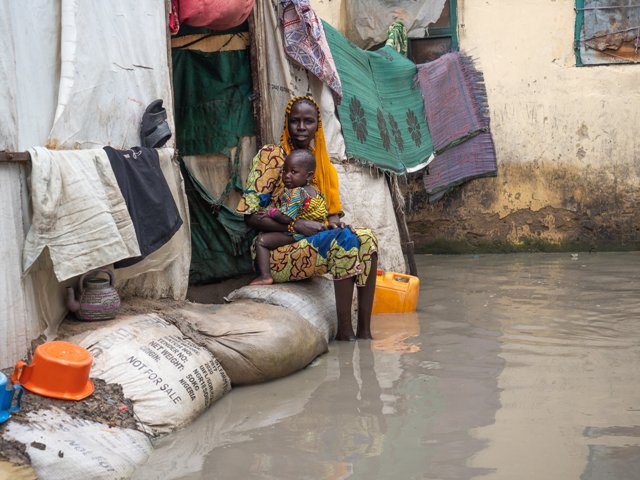IOM scals up efforts to meet needs of flood-affected people in South Sudan
More than three months of unprecedented rainfall has submerged entire communities resulting in the temporary mass displacement of people and the disruption of basic services.

- Country:
- South Sudan
The International Organization for Migration (IOM) has scaled up efforts to meet the needs of internally displaced people and host communities in response to devastating floods that have affected over 900,000 people in South Sudan.
“It was distressing to witness the level of destruction and suffering that the floods have caused,” IOM Chief of Mission in South Sudan, Jean-Philippe Chauzy said following a recent visit to flooded areas in Jonglei region.
“I spoke to one elderly displaced resident who had sought refuge in an overcrowded church standing on a small patch of dry ground in the middle of a quagmire. She told me she cannot remember floods of this magnitude.”
More than three months of unprecedented rainfall has submerged entire communities resulting in the temporary mass displacement of people and the disruption of basic services. Thousands of homes and shelters have been destroyed, crops that sustain local livelihoods wiped out, and there are fears the contaminated water will spark an outbreak of disease.
Prior to the flooding, nearly two-thirds of the affected areas reported critical levels of malnutrition primarily affecting children and pregnant women.
On 26 October, the Government of South Sudan declared a state of emergency in 32 counties in Jonglei, Upper Nile, Warrap, Eastern Equatoria and Northern Bahr el Ghazal regions, a development that was commended by humanitarian partners in the country.
Through an integrated and coordinated response to the ongoing crisis, IOM in support of the government has:
Participated in the initial assessment missions in most affected locations and distributed aqua tabs to 3,680 households.
Released Water, Sanitation and Hygiene (WASH), shelter and non-food items (S/NFIs) such as aqua tabs, blankets, mosquito nets, tarpaulin sheets, rubber ropes, collapsible jerry cans, and water filter cloths to be distributed to an initial 1,500 households targeted in the heavily affected town of Pibor in Jonglei. In addition, IOM continues the prepositioning of supplies from the capital Juba and Rumbek to Bor in Jonglei to support the emergency flood response with the overall target of assisting 70,000 flood-affected households.
Supported six implementing partners to provide flood-related lifesaving relief to affected communities through the Rapid Response Fund (RRF).
Produced a set of maps providing geo-referenced analysis of more than 250 locations affected by the flooding.
IOM has also provided plastic sheeting, mosquito nets, blankets, and sleeping mats to 16,711 flood-affected population in the Abyei Administration Areas.
Despite concerted efforts by IOM and other humanitarian partners, assistance has not reached some communities due to impassable roads and flooded airstrips leading to increased unmet needs for vulnerable communities.
“Access constraints to some of the affected areas are putting pressure on the flood response,” said Chauzy.
“And while IOM continues to borrow against relief items meant for the dry season to respond to this emergency, there is a need to replenish supplies that will be needed this coming year, especially given the anticipated long-term humanitarian needs as a result of the flooding.”
IOM’s emergency response to flood-affected populations in South Sudan and the Abyei Administration Area is supported by DFID, ECHO, OFDA, and USAID.
The heavy rains have hit areas that were already facing high humanitarian needs. Across the 32 flooded counties, more than three million people were in need of assistance even before the rains. Sixty-three percent of the flood-affected counties are classified as facing extreme levels of Acute Malnutrition Phase 4 (critical), mostly impacting children and new mothers.
Critical needs include access to safe drinking water, antimalarials and other basic drugs, and plastic sheets to be used as temporary shelters. The degradation or loss of crops and other sources of livelihoods, and an estimated 17,000 hectares of productive land affected by the flooding will cause longer-term humanitarian needs and reduce food security into 2020.
An additional USD 61.5 million, not budgeted within the current Humanitarian Response Plan for South Sudan, is needed to support those most in need of assistance, ensure the protection of the most vulnerable and avert loss of life.
(With Inputs from APO)










